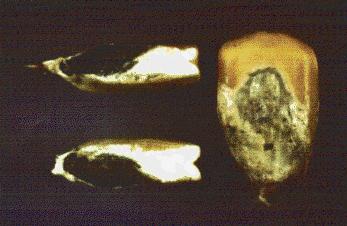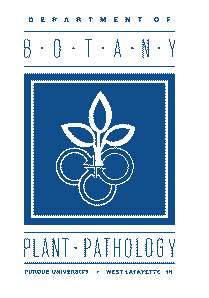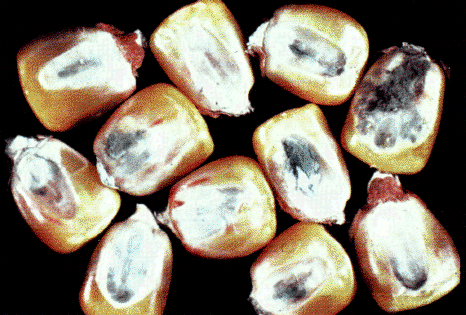

BP-49
CORN DISEASES
Purdue University
Cooperative Extension Service
West Lafayette, IN 47907
A common problem observed by grain handlers is the appearance of corn with germ discoloration. Discoloration of the germ indicates kernel death. The death is usually due to fungi (molds) that invade the germ tissue during harvest and/or storage. When the discoloration is blue-green this is referred to as "blue eye". Blue eye is caused by the production of blue-green fungal spores on the germ tissue. Two groups of fungi usually cause blue eye; Aspergillus glaucus or species of Penicillium. The presence of blue eye usually indicates that the grain has been improperly stored. Identifying the fungus responsible for the blue eye is of value because it may help determine what may have gone wrong in storage.
The fungus Aspergillus glaucus is a common cause of blue eye. Spores of the fungus are present around all grain storage facilities. Thus, infection of the grain can occur during all stages of the drying and storage process. Prior to storage. grain often appears to be of good quality with no sign of blue eye. However after several months in storage, blue eye appears when the grain is removed from the bin. The most likely time for infection is during harvest and drying. If there is a delay in the grain drying process because of broken machinery. unusually high grain moisture. or a prolonged wet-holding period, infection and the production of large amounts of spores may occur. Because Aspergillus glaucus can grow at moistures as low as 14.5%. the fungus continues growing in the germ during the months of storage. eventually showing up as blue eye.

Penicillium, especially Penicillium oxalicum, requires fairly high moisture levels to grow and will not grow in corn below 17-18% moisture. Infection of kernels by this fungus can occur in the field if ears are damaged by insects, but blue eye usually does not develop until after harvest. This fungus is also the common cause of blue eye in corn that is stored on the cob in cribs. Penicillium can also cause extensive blue eye in isolated areas of coin bins where moisture accumulates, such as near the surface of the bin.
The best method of controlling blue eye is by preventing delays in the drying process due to prolonged holding of wet corn. In addition, it is important to periodically check grain at the surface of bins to insure that moisture is not accumulating.
A frequent question asked by people who have a blue eye problem in their grain is: are mycotoxins present? It is not possible to answer this question without knowing the identity of the fungus causing the blue eye. Penicillium oxalicum and Aspergillus glaucus, the fungi primarily associated with blue eye. do not produce any known mycotoxins. However, there are other Penicillium species that produce the mycotoxin ochratoxin, and Aspergillus species that produce aflatoxin or ochratoxin. If these fungi are the cause of the blue eye. there is a high potential for mycotoxins.
Species determination takes time and expertise. thus the best way to determine if there is a mycotoxin problem is to test for ochratoxin and aflatoxin. If you have questions about identifying fungi or the use of mycotoxin tests, contact the Plant and Pest Diagnostic Laboratory (P&PDL) at Purdue University. Additional information about mycotoxins can be obtained by requesting publication BP-47 Mycotoxins and Mycotoxin Test Kits from the Media Distribution Center, (317) 494-6794.

New 8/95
Reference to products in this publication is not intended to be an endorsement to the exclusion of others which may be similar. Persons using such products assume responsibility for their use in accordance with current label directions of the manufacturer.
Cooperative Extension Work in Agriculture and Home Economics, State of Indiana, Purdue University and U.S. Department of Agriculture Cooperating. H.A. Wadsworth, Director, West Lafayette, IN. Issued in furtherance of the Acts of May 8 and June 30, 1914. It is the policy of the Cooperative Extension Service of Purdue University that all persons shall have equal opportunity and access to our programs and facilities.